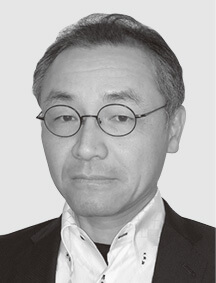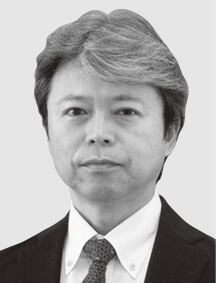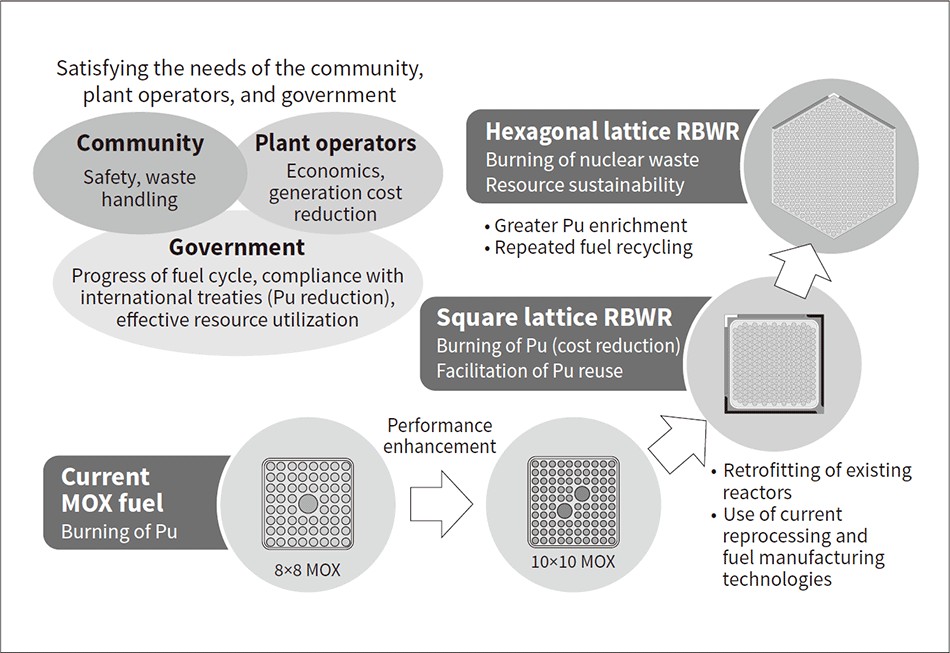Hitachi’s Nuclear Power Business
Hitachi-GE Nuclear Energy, Ltd. has put forward a vision for nuclear power that seeks to reduce initial investment risk, provide a reliable supply of power over the long term, and make radioactive waste less hazardous. It is currently developing three new reactor designs aimed at realizing this vision: the BWRX-300 small modular reactor, the RBWR light-water-cooled fast reactor, and the PRISM small modular sodium-cooled fast reactor. The BWRX-300 has been comprehensively simplified to provide combination of safety and economic performance, the RBWR is a fast reactor based on proven light-water cooling technology, and the PRISM uses innovative technology to deliver a high level of both intrinsic safety and economic performance. In the future, Hitachi-GE intends to continue developing technologies to solve the global energy problem and to realize the potential of these reactor designs at an early date.




Fig. 1—Hitachi’s Vision for Nuclear Power and Development Strategy Drawing on its experience with the construction of boiling water reactors (BWRs) and fuel cycle technologies, Hitachi is utilizing international open innovation for the joint development of new reactor designs that reduce initial investment risk, provide a reliable supply of power over the long term, and make radioactive waste less hazardous.
Drawing on its experience with the construction of boiling water reactors (BWRs) and fuel cycle technologies, Hitachi is utilizing international open innovation for the joint development of new reactor designs that reduce initial investment risk, provide a reliable supply of power over the long term, and make radioactive waste less hazardous.
Drawing on its experience with the construction of boiling water reactors (BWRs) and fuel cycle technologies, Hitachi-GE Nuclear Energy, Ltd. (Hitachi-GE) is utilizing open innovation for the joint international development of three new reactor designs. These are the next-generation small modular reactor BWRX-300 that has been made smaller and simpler to provide both safety and economic performance, the resource-renewable boiling water reactor (RBWR) that incorporates proven light-water cooling technology, and the power reactor innovative small module (PRISM), a small modular sodium-cooled fast reactor that uses metallic fuel and features intrinsic safety (see Figure 1).
This article describes the features of these three reactors and the technologies being developed to enable their practical implementation.
For safe and clean nuclear power generation to become more competitive in global markets will require not only lower capital costs but also a reduction in capital risk, with a generation cost equal to or less than that of alternatives such as gas combined cycle (thermal). As this is increasing the need for small and economical reactors, Hitachi-GE is working with its US partner, GE Hitachi Nuclear Energy (GEH), on a joint US-Japan project to develop a next-generation small light-water reactor with enhanced economic performance that does not compromise its high level of safety.
Fig. 2—Diagram and Main Specifications of Next-generation Small Modular Reactor BWRX-300 The next-generation small modular reactor BWRX-300 has a small and simple reactor containment vessel that is embedded into the ground to make it more resilient to external events, including things like terrorist attacks. It features passive safety systems that do not require an alternating current power supply to operate.
The next-generation small modular reactor BWRX-300 has a small and simple reactor containment vessel that is embedded into the ground to make it more resilient to external events, including things like terrorist attacks. It features passive safety systems that do not require an alternating current power supply to operate.
Figure 2 shows a diagram of the BWRX-300 and lists its main specifications. The BWRX-300 is a compact BWR with an output in the 300-MWe class. A BWR uses a simple direct-cycle design in which steam from the reactor is supplied directly to the turbine. While the recirculation loop ran outside the reactor pressure vessel on early BWRs (BWR-2 to -6), the advanced BWR (ABWR) used a simplified configuration in which the recirculation loop is replaced with Reactor Internal Pumps. This was followed by the simplified BWR (SBWR) and economic simplified BWR (ESBWR) in which the core can be cooled entirely by natural circulation. The “X” in the BWRX-300 name comes from the fact that this reactor represents the 10th iteration of this BWR development. To further simplify the plant systems, the BWRX-300 is based on an innovative new concept that comprehensively reduces the probability of a loss-of-coolant accident (LOCA), one of the main reactor accident modes, by improving the reliability of the pressure boundary for the primary reactor coolant. As a result, it is estimated that this design will reduce the material volume of the reactor buildings per unit of output to roughly half that of a large reactor by eliminating the need for emergency core cooling pumps and other major items of equipment while improving safety, and by allowing the reactor building and reactor containment vessel to be significantly smaller. This simplification of plant systems improves reliability by minimizing the equipment count while also reducing the amount of material to be dealt with in decommissioning. Development risk and licensing approval risk have also been minimized by using proven existing technologies for most reactor system equipment with the aim of early commercialization. The main new development relates to the technology for improving the reliability of the pressure boundary for the primary reactor coolant.
One of the factors behind the higher construction risk for large reactors in recent years has been the potential for cost escalation due to the long construction schedules they entail. As well as taking advantage of the particular benefits that come with small reactors, namely that construction risk can be reduced through a higher proportion of modularization with factory-built modules being installed in one piece at the site, the BWRX-300 also aims to provide shorter construction schedules and cost savings through the proactive adoption of advanced techniques from general industry for peripheral equipment and construction methods.
Hitachi-GE also plans to look into other benefits for safety and public acceptance. One example is a planned study into whether plants’ emergency planning zones (EPZs) can be made smaller thanks to design features such as the use of passive safety systems that can maintain cooling in the absence of electric power and the fact that the reduced output also means a smaller quantity of radioactive material in the reactor.
Hitachi-GE plans to develop the following technologies to enable the BWRX-300 plant concept to be put into practice.
The plan is to complete the conceptual design during FY2020. This will be followed by preliminary safety analysis, testing, and site selection in the USA, with the aim of having the first plant commence operation in North America around 2030. In parallel with this, further steps will be taken to expand the market for the BWRX-300 by participating in projects in Japan, Europe, and the USA.
Fig. 3—RBWR The fuel rods are more tightly packed to increase neutron energy compared to a conventional BWR by minimizing deceleration due to neutron collisions with coolant. Otherwise, the design uses the same turbines, safety systems, and other technologies as conventional BWR systems.
The fuel rods are more tightly packed to increase neutron energy compared to a conventional BWR by minimizing deceleration due to neutron collisions with coolant. Otherwise, the design uses the same turbines, safety systems, and other technologies as conventional BWR systems.
The RBWR was designed to make good use of resources and reduce the load imposed on the environment by spent fuel. Along with more tightly packed fuel rods, the design takes advantage of the boiling of coolant water in the reactor (a characteristic feature of BWRs) to increase neutron energy compared to a conventional BWR by minimizing deceleration due to neutron collisions with coolant. By doing so, it is able to reuse as fuel the transuranium elements (TRUs) such as plutonium and minor actinides that are present in spent fuel and remain radioactive for a very long time.
Figure 3 shows an overview of the RBWR(1). Although the core has been rearranged to make it optimal for TRU fuel, existing commercially proven BWR technologies are used for components other than the core, such as the turbines and safety systems. One problem that typically arises in reactors such as the RBWR that use high-energy neutrons to burn TRUs is that they are less able to benefit from a negative void coefficient of reactivity. This is the feedback effect whereby the rise in the fraction of voids (bubbles) in the coolant as the output is increased in turn tends to reduce output of the reactor. To deal with this, the RBWR achieves a negative void coefficient of reactivity by arranging the TRU fuel into two separate zones that increases neutron leakage when an increase in output raises the void fraction of the coolant. To enable this sort of detailed evaluation of the behavior inside nuclear reactors, Hitachi has been working with research institutions in Japan, the UK, and the USA to improve reactor core analysis techniques and verify their applicability(2), (3), (4).
Fig. 4—Concept Behind Introduction of RBWR The aim is to work toward the practical application of hexagonal lattice RBWRs in conjunction with progress in other areas like reprocessing and fuel manufacturing technologies by building up experience with the use of tight-lattice fuel and high-energy neutrons in light-water reactors while also contributing to progress on the fuel cycle.
The aim is to work toward the practical application of hexagonal lattice RBWRs in conjunction with progress in other areas like reprocessing and fuel manufacturing technologies by building up experience with the use of tight-lattice fuel and high-energy neutrons in light-water reactors while also contributing to progress on the fuel cycle.
In response to public expectations, the intention is for the development of the RBWR to take place in stages, in step with progress on the development of fuel cycle technologies. Accordingly, Hitachi-GE started work on the development of an RBWR that provides flexibility in planning the use of plutonium by introducing the use of tight-lattice fuel in existing BWRs. Figure 4 shows the concept behind the introduction of the RBWR. The square lattice RBWR can be implemented through the replacement or new installation of components that can easily be achieved, such as the fuel bundles and control rods from existing BWRs. It is also anticipated that existing reprocessing and mixed-oxide (MOX) fuel manufacturing techniques will be used. The square lattice RBWR will also facilitate future recycling and make better use of resources because, as it consumes plutonium, it also leaves the spent fuel with a higher proportion of fissionable plutonium isotopes than does the current MOX fuel. While facilitating early implementation of the use of tight-lattice fuel and high-energy neutrons in light-water reactors through this step-by-step verification and also contributing progress on the fuel cycle, the aim is to move on to the practical application of hexagonal lattice RBWRs with their superior resource sustainability in conjunction with progress in other areas like reprocessing and fuel manufacturing technologies.
Fig. 5—Diagram of Standard Reactor Module In its standard configuration, one power block for the PRISM is made up of two reactor modules and one turbine system.
In its standard configuration, one power block for the PRISM is made up of two reactor modules and one turbine system.
Fig. 6—Diagram of RVACS RVACS is a system for using the natural circulation of air from outside the containment vessel to remove decay heat from the core. It is a passive safety system that is able to cool the core in the event of a problem without needing an external power supply or human operation.
RVACS is a system for using the natural circulation of air from outside the containment vessel to remove decay heat from the core. It is a passive safety system that is able to cool the core in the event of a problem without needing an external power supply or human operation.
While nuclear power has been commercialized using light-water reactors, various countries have been developing technology for fast reactors with future resource sustainability in mind. Fast reactors generate more fissile fuel in the process of consuming it and feature a high level of flexibility in fuel composition. The initial design for PRISM was done by General Electric Co. (GE) in the 1980s and GEH is currently handling its ongoing development. The reactor vessel auxiliary cooling system (RVACS) is an important passive safety system for decay heat removal, where the requirement is for the provision of long-term core cooling in the event of an accident. Along with the use of metallic fuel, which has greater safety features, it enables small modular sodium-cooled fast reactors that minimize initial investment and a high level of inherent safety and reliability without requiring a power supply or human operation. PRISM plants can be configured flexibly by selecting as many modules as needed, with each one having a standard output of 311 MWe*. Figure 5 shows a diagram of a reactor module. In accordance with the fast reactor development roadmap formulated by the Ministry of Economy, Trade and Industry in December 2018, Hitachi-GE has set a target of building PRISM, which has high economic and safety performance, in Japan in the 2040s.
RVACS is a system for using the natural circulation of air from outside the containment vessel to remove decay heat from the core. Figure 6 shows how it works. Air is drawn into the reactor building from the stack to cool the containment vessel and the heated air is then discharged. RVACS is a passive safety system that does not require an external power supply. In the event of an abnormal condition, the temperature of the sodium in the reactor increases and this hot sodium overflows onto the interior walls of the reactor where the higher temperature increases the amount of heat being passively removed by the air. This also eliminates any need for human operation to initiate RVACS.
The physical and chemical properties of the metallic fuel (U-Pu-Zr alloy) used in PRISM include a high heat density, high thermal conductivity, low specific heat, high coefficient of thermal expansion, and good affinity with the sodium coolant. With these properties, it has numerous economic and safety advantages, including a high breeding ratio, reduced formation of higher actinides, ability to burn higher actinides, and negative reactivity characteristics with respect to coolant and fuel temperature, a uniform temperature distribution in the fuel pins, a lower temperature than oxide fuel under both normal and abnormal conditions, and less thermal energy retained in the core. At a test conducted at the Experimental Breeder Reactor II (EBR-II) in the USA to simulate an accident scenario, the safety advantages of metallic fuel enabled the abnormal condition to be successfully settled without any safety system initiation.
With regard to future construction and development plans, the intention is to work with the developer (GEH) on a feasibility study for building a plant in Japan. This will involve studies being undertaken from 2020 to 2021 to consider how well the design will comply with the regulatory requirements likely to be in place at the time of construction, investigate construction scenarios, and review the safety of the RVACS and metallic fuel that are key technical features of the design. A plan for demonstration is also to be studied by 2023. This will be followed by the demonstration project, detailed design, and licensing approvals process, with the aim of building a plant in the 2040s.
Hitachi-GE is utilizing open innovation for the joint international development of three new reactor designs, the BWRX-300, RBWR, and PRISM, with the aims of reducing initial investment risk, providing a reliable supply of power over the long term, and making radioactive waste less hazardous. The intention for the future is to undertake technology development with consideration for how to improve public acceptance and encourage investment in clean energy, including by taking account of nuclear power policy and user opinions, and thereby to expedite the practical realization of these designs.